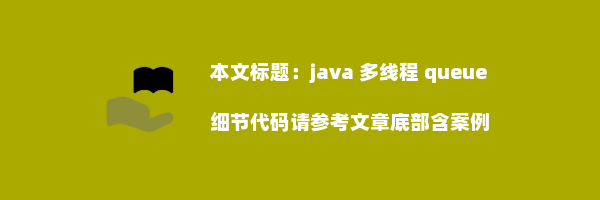java 多线程 queue

在Java多线程编程中,Queue(队列)是一种非常关键的数据结构,它允许线程安全地存储和检索元素。我经常在项目中使用Queue来实现线程间的通信和数据同步。本文将从第一人称的角度,深入探讨Java中Queue的使用方法、核心类与方法、使用场景,并通过两个详细的代码案例进行阐释。
定义与目的
Queue是一种先进先出(FIFO)的数据结构,它在多线程环境中扮演着至关重要的角色。在多线程编程中,线程之间的数据共享和同步是一个复杂的问题,而Queue提供了一种简单、高效的方式来处理这一问题。使用Queue可以避免直接的线程间通信,从而减少并发问题,如死锁和竞态条件。
核心类与方法
Java中与Queue相关的主要接口是java.util.Queue,它定义了一系列用于操作队列的方法,如add(), offer(), poll(), remove()等。在多线程环境下,我们通常使用线程安全的Queue实现,如java.util.concurrent.LinkedBlockingQueue或java.util.concurrent.ArrayBlockingQueue。
使用场景
Queue在多线程中的使用场景非常广泛,包括但不限于:
- 任务调度:在生产者-消费者模型中,
Queue可以作为任务队列,生产者将任务放入队列,消费者从队列中取出任务执行。 - 数据缓冲:在数据流处理中,
Queue可以作为缓冲区,临时存储数据流,以平衡生产者和消费者之间的速度差异。 - 线程间通信:
Queue还可以用作线程间的通信媒介,传递消息或数据。
代码案例
案例一:生产者-消费者模型
import java.util.concurrent.BlockingQueue;
import java.util.concurrent.LinkedBlockingQueue;
public class ProducerConsumerExample {
private static final BlockingQueue<Integer> queue = new LinkedBlockingQueue<>();
public static void main(String[] args) throws InterruptedException {
Thread producer = new Thread(new Producer(queue));
Thread consumer = new Thread(new Consumer(queue));
producer.start();
consumer.start();
}
static class Producer implements Runnable {
private final BlockingQueue<Integer> queue;
public Producer(BlockingQueue<Integer> queue) {
this.queue = queue;
}
@Override
public void run() {
for (int i = 0; i < 10; i++) {
try {
queue.put(i);
System.out.println("Produced: " + i);
} catch (InterruptedException e) {
Thread.currentThread().interrupt();
}
}
}
}
static class Consumer implements Runnable {
private final BlockingQueue<Integer> queue;
public Consumer(BlockingQueue<Integer> queue) {
this.queue = queue;
}
@Override
public void run() {
while (true) {
try {
int item = queue.take();
System.out.println("Consumed: " + item);
} catch (InterruptedException e) {
Thread.currentThread().interrupt();
}
}
}
}
}案例二:线程间通信
import java.util.concurrent.ConcurrentLinkedQueue;
public class InterThreadCommunication {
private static final ConcurrentLinkedQueue<String> queue = new ConcurrentLinkedQueue<>();
public static void main(String[] args) {
Thread thread1 = new Thread(() -> {
queue.add("Message from thread 1");
});
Thread thread2 = new Thread(() -> {
while (true) {
if (!queue.isEmpty()) {
String message = queue.poll();
System.out.println("Received: " + message);
}
}
});
thread1.start();
thread2.start();
}
}相关问题及回答
| 问题 | 回答 |
|---|---|
| 如何保证Queue的线程安全? | 使用线程安全的Queue实现,如LinkedBlockingQueue或ArrayBlockingQueue。 |
| 为什么在多线程环境中使用Queue? | 为了线程安全地存储和检索元素,避免直接的线程间通信导致的并发问题。 |
| Queue的典型使用场景有哪些? | 任务调度、数据缓冲、线程间通信等。 |
| 如何选择适合的Queue实现? | 根据具体需求选择,如对性能的要求、是否需要阻塞操作等。 |
通过上述两个案例,我们可以看到Queue在多线程编程中的应用是多方面的,它不仅能够提高程序的效率,还能简化线程间的数据共享和同步问题。希望本文能够帮助你更好地理解和使用Java中的Queue。
上一篇:java 多线程 future
下一篇:java 多线程 事务
相关文章
猜你喜欢
-
用来写java程序的软件
推荐原创
在Java编程的浩瀚海洋中,我曾是一名孜孜不倦的探索者,寻找着能让我高效编写代码的灯塔。在这段旅程中,我发现了两个强大的编程工具——Eclipse和Intell...
-
java锁机制面试题
推荐原创
在软件开发中,多线程环境是常见的场景,而线程安全问题也随之而来。Java作为一种广泛使用的编程语言,提供了多种锁机制来保证线程安全。在这篇文章中,我将以第一人称...
-
java连接redis集群主节点挂了导致无法存储数据
推荐原创
作为一名资深的后端开发者,我经常面对数据存储与高可用性的问题。Redis作为当前流行的内存数据结构存储系统,以其高性能、高可用性而广受欢迎。然而,即使是Redi...
-
java转换小写
推荐原创
在编程的世界里,字符串处理是一项基本且频繁的任务。作为一名Java开发者,我经常需要处理字符串的大小写转换,以确保数据的一致性和格式的正确性。字符串转换为小写是...
-
java转小写快捷键
推荐原创
在Java编程的世界中,字符串处理是一项非常基础且频繁的操作。其中,将字符串转换为小写是一个常见的需求。作为一名Java开发者,我经常需要处理各种字符串转换问题...
-
Java读取配置文件的注解
推荐原创
在软件开发过程中,配置文件是不可或缺的一部分,它允许开发者在不修改代码的前提下调整应用程序的行为。Java提供了多种方式来读取配置文件,其中使用注解(Annot...
-
java计算时间间隔
推荐原创
在软件开发中,时间管理是一个不可或缺的部分,尤其是当我们需要记录操作的执行时间或比较两个时间点的差异时。Java提供了多种方式来处理时间计算,其中最常见的两种是...
-
java获取当前目录的上两层目录
推荐原创
在Java编程的世界中,文件和目录的操作是一项基础而重要的技能。作为一名Java开发者,我经常需要处理文件系统的各种任务,比如读取文件、写入数据、或者仅仅是导航...
-
java线程状态和操作系统线程状态
推荐原创
正文:
-
java的switch的default
推荐原创
在Java编程语言中,`switch`语句是一种条件语句,它允许一个变量与多个值进行比较,从而选择执行不同的代码块。它是一种比多个`if-else`语句更加清晰...
-
java的scanner函数
推荐原创
在软件开发的旅程中,我经常与Java的Scanner类打交道。这个类是Java标准库中处理输入的强大工具,它允许我们从不同的输入源读取数据。今天,我将分享两个详...
-
java测试类怎么调用方法
推荐原创
在软件开发的漫长旅途中,测试环节犹如一盏明灯,指引着代码质量的航向。作为一名Java开发者,我深知测试类的重要性。它不仅是代码质量的守护者,更是开发效率的加速器...
-
java断点续传记录下载位置
推荐原创
在网络通信的世界中,断点续传技术是一种非常实用的功能,它允许用户在下载过程中遇到中断时,能够从中断点继续下载,而不是从头开始。这不仅节省了时间,也减少了网络资源...
-
java文字转语音给前端输出
推荐原创
在数字化时代,交互方式的多样化是提升用户体验的关键。文字转语音(Text-to-Speech,TTS)技术作为其中一种,能够将文本信息转化为语音输出,为视障用户...
-
java数组转成list
推荐原创
在Java编程中,数组和List是两种常见的数据结构,它们各自有着独特的用途和优势。作为一个Java开发者,我经常需要在数组和List之间进行转换,以适应不同的...
-
java数组定义的几种方式
推荐原创
在Java编程语言中,数组是一种基本的数据结构,它允许我们将一组固定数量的相同类型的元素存储在一起。数组的使用非常广泛,因为它们提供了一种简单的方式来组织和访问...
-
java数据库连接池的作用
推荐原创
在Java的世界里,数据库连接池是一种至关重要的技术,它极大地提升了应用程序与数据库交互的效率。我曾与数据库连接池紧密合作,见证了它如何优化资源管理,减少系统开...
-
java数据库连接池原理
推荐原创
正文:
-
java数字转字符char
推荐原创
在Java编程中,我们经常需要将数字转换为字符,这在处理ASCII编码、文件编码、网络协议等方面尤为重要。数字到字符的转换不仅仅是一个简单的操作,它涉及到字符编...
-
java接口自动化测试实战课程
推荐原创
在软件开发的海洋中,自动化测试如同一盏明灯,指引着代码质量的航向。我,作为一名资深的测试工程师,深知自动化测试在提高软件质量和开发效率中的重要性。今天,我将带领...
-
java怎么调用方法实现数组遍历
推荐原创
-
java怎么获取数组的值
推荐原创
作为一名Java开发者,我深知数组在编程中的重要性。数组是一种基本的数据结构,它允许我们存储一系列相同类型的元素。在Java中,数组的使用无处不在,从简单的排序...
-
Java开发环境配置实验报告
推荐原创
-
java定义数组的几种方式
推荐原创
#### 开篇
-
java如何运行一个应用程序
推荐原创
#### 开篇
-
java堆排序时间复杂度
推荐原创
大家好,我是Kimi,一个由月之暗面科技有限公司开发的人工智能助手。今天,我将带大家深入了解一种高效的排序算法——堆排序。堆排序是一种基于二叉堆数据结构的比较类...
-
JAVA哈希表什么时候改的
推荐原创
在Java的世界中,数据结构的演变总是伴随着性能和功能的不断优化。作为一名Java开发者,我经常需要选择适合项目需求的数据结构。今天,我想分享关于Java中哈希...
-
java向下转型格式
推荐原创
在Java的世界里,类型转换是程序设计中不可或缺的一部分。作为面向对象语言的代表,Java提供了向上转型和向下转型两种类型转换方式。向上转型是隐式的,而向下转型...
-
java反射调用方法传参为null
推荐原创
在Java的世界中,反射是一个强大的特性,它允许程序在运行时查询、访问和修改类、接口、字段和方法的属性。通过反射,我们可以动态地调用方法,即使这些方法的参数为`...
-
java十种常见的异常
推荐原创
在Java编程的世界里,异常处理是确保程序稳定性和健壮性的关键。作为一名开发者,我深知掌握异常处理机制的重要性。异常是程序运行时发生的不正常情况,它们可以是编译...
-
java动态编译的代码找不到依赖
推荐原创
在Java的世界里,动态编译是一个强大的概念,它允许开发者在运行时编译Java源代码。这在某些情况下非常有用,比如在开发IDE插件、构建工具或者需要在运行时生成...
-
java动态编译源码
推荐原创
在Java编程的世界中,动态编译是一种强大的技术,它允许开发者在运行时编译Java源代码。这种技术在某些场景下非常有用,例如在需要根据用户输入生成代码,或者在开...
-
java判断两字符串相等
推荐原创
在Java编程的世界里,字符串是最常见的数据类型之一。我们经常需要判断两个字符串是否相等。但你知道吗?在Java中,字符串相等的判断并不像看上去那么简单。今天,...
-
java使用redis集群
推荐原创
在现代软件开发中,缓存系统是提升应用性能的关键组件之一。Redis,作为一种高性能的键值存储数据库,因其出色的读写速度和丰富的数据结构支持,成为了缓存解决方案的...
-
java互斥锁和同步锁
推荐原创
正文:
-
eclipse如何创建javaee项目
推荐原创
#### 开篇
-
java的scanner怎么导入
推荐原创
在Java编程世界中,与用户进行交互是必不可少的一部分。而Scanner类,作为Java标准库中用于获取用户输入的强大工具,扮演着至关重要的角色。我将从第一人称...
-
java的map方法
推荐原创
在编程的世界里,我经常与Java打交道,尤其是它的集合框架。Map是Java集合框架中一个非常重要的接口,它存储键值对(key-value pairs),允许我...
-
java生成csv文件单元格设置数值模式
推荐原创
在软件开发中,数据的导入和导出是一项常见的任务。CSV(逗号分隔值)文件因其简单性和广泛的兼容性而成为数据交换的优选格式之一。在Java中生成CSV文件并不复杂...
-
java流程图计算步骤
推荐原创
在软件开发的海洋中,Java作为一艘强大的船只,承载着无数开发者的梦想与创造。我,作为一名Java开发者,深知在编程的旅途中,流程图是导航的重要工具。它不仅帮助...
-
Java数据类型转换形式有哪几种分别要符合什么规则
推荐原创
在Java编程中,数据类型转换是实现不同数据类型间相互操作的基础。它允许我们根据需要将数据从一个类型转换为另一个类型,以便于进行计算、比较或存储。数据类型转换的...
-
java实现二进制转十六进制
推荐原创
在软件开发中,数据格式的转换是常见的需求之一。特别是二进制与十六进制之间的转换,由于其在计算机系统中的广泛应用,成为了程序员必须掌握的技能。本文将从第一人称的角...
-
java定义数组必须定义长度么
推荐原创
在Java编程语言中,数组是一种基本的数据结构,它允许我们存储一系列相同类型的元素。与Python等其他语言不同,Java数组在定义时必须指定其长度和元素类型。...
-
java定义数组不赋值值为多少
推荐原创
#### 开头:
-
java大文件上传内存溢出
推荐原创
在处理大型文件上传时,Java应用程序经常面临内存溢出的问题。这主要是因为Java虚拟机(JVM)在处理大文件时会消耗大量的内存资源。本文将详细解释大文件上传时...
-
java反射调用方法 参数限制
推荐原创
在Java的世界里,反射是一个强大而复杂的功能,它允许程序在运行时查询、访问和操作类的对象。反射的用途广泛,从动态加载类到调用方法,再到获取字段值,它几乎无所不...
-
java去空格和换行
推荐原创
在Java编程中,字符串处理是一项基础而重要的技能。作为开发者,我们经常需要对字符串进行各种操作,包括去除其中的空格和换行符。这不仅关乎代码的整洁性,还可能影响...
-
java匿名类和匿名内部类
推荐原创
在Java的世界里,我曾被那些隐藏在代码深处的匿名类和匿名内部类所吸引。它们如同编程界的隐秘特工,执行任务时不留下任何身份痕迹。今天,我将带领大家深入探索这两种...
-
java创建list集合对象
推荐原创
#### 开篇
-
javaword转pdf工具类
推荐原创
作为一名软件开发者,我经常需要处理各种文档格式的转换,其中Word转PDF是日常工作中常见的需求之一。Word文档是一种广泛使用的文档编辑格式,而PDF则因其跨...
领取相关Java架构师视频资料

